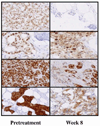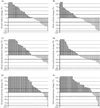Molecular characterization of enzalutamide-treated bone metastatic castration-resistant prostate cancer
- PMID: 24882673
- PMCID: PMC4247811
- DOI: 10.1016/j.eururo.2014.05.005
Molecular characterization of enzalutamide-treated bone metastatic castration-resistant prostate cancer
Abstract
Background: Enzalutamide is a novel antiandrogen with proven efficacy in metastatic castration-resistant prostate cancer (mCRPC).
Objective: To evaluate enzalutamide's effects on cancer and on androgens in blood and bone marrow, and associate these with clinical observations.
Design, setting, and participants: In this prospective phase 2 study, 60 patients with bone mCRPC received enzalutamide 160mg orally daily and had transilial bone marrow biopsies before treatment and at 8 wk of treatment.
Outcome measurements and statistical analysis: Androgen signaling components (androgen receptor [AR], AR splice variant 7 (ARV7), v-ets avian erythroblastosis virus E26 oncogene homolog [ERG], cytochrome P450, family 17, subfamily A, polypeptide 1 [CYP17]) and molecules implicated in mCRPC progression (phospho-Met, phospho-Src, glucocorticoid receptor, Ki67) were assessed by immunohistochemistry; testosterone, cortisol, and androstenedione concentrations were assessed by liquid chromatography-tandem mass spectrometry; AR copy number was assessed by real-time polymerase chain reaction. Descriptive statistics were applied.
Results and limitations: Median time to treatment discontinuation was 22 wk (95% confidence interval, 19.9-29.6). Twenty-two (37%) patients exhibited primary resistance to enzalutamide, discontinuing treatment within 4 mo. Maximal prostate-specific antigen (PSA) decline ≥ 50% and ≥ 90% occurred in 27 (45%) and 13 (22%) patients, respectively. Following 8 wk of treatment, bone marrow and circulating testosterone levels increased. Pretreatment tumor nuclear AR overexpression (> 75%) and CYP17 (> 10%) expression were associated with benefit (p = 0.018). AR subcellular localization shift from the nucleus was confirmed in eight paired samples (with PSA decline) of 23 evaluable paired samples. Presence of an ARV7 variant was associated with primary resistance to enzalutamide (p = 0.018). Limited patient numbers warrant further validation.
Conclusions: The observed subcellular shift of AR from the nucleus and increased testosterone concentration provide the first evidence in humans that enzalutamide suppresses AR signaling while inducing an adaptive feedback. Persistent androgen signaling in mCRPC was predictive of benefit and ARV7 was associated with primary resistance.
Patient summary: We report a first bone biopsy study in metastatic prostate cancer in humans that searched for predictors of outcome of enzalutamide therapy. Benefit is linked to a pretreatment androgen-signaling signature.
Trial registration: ClinicalTrials.gov identifier NCT01091103.
Keywords: Adaptive feedback mechanism; Androgen receptor; Androgen signaling inhibition; Bone metastasis; Bone tumor microenvironment; Castration-resistant prostate cancer; Enzalutamide; Predictors of outcome; Primary resistance to enzalutamide; Tissue-based research.
Published by Elsevier B.V.
Conflict of interest statement
Figures




Comment in
-
Prostate cancer: Predicting response to androgen receptor signalling inhibition.Nat Rev Urol. 2014 Aug;11(8):433-5. doi: 10.1038/nrurol.2014.179. Epub 2014 Jul 22. Nat Rev Urol. 2014. PMID: 25048863 No abstract available.
-
Toward predictive signatures of enzalutamide response and resistance.Eur Urol. 2015 Jan;67(1):61-63. doi: 10.1016/j.eururo.2014.08.012. Epub 2014 Aug 20. Eur Urol. 2015. PMID: 25151015 No abstract available.
References
-
- Scher HI, Fizazi K, Saad F, et al. Increased survival with enzalutamide in prostate cancer after chemotherapy. N Engl J Med. 2012;367:1187–1197. - PubMed
Publication types
MeSH terms
Substances
Associated data
Grants and funding
LinkOut - more resources
Full Text Sources
Other Literature Sources
Medical
Molecular Biology Databases
Research Materials
Miscellaneous

